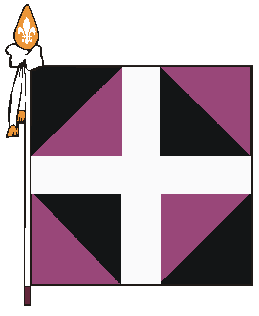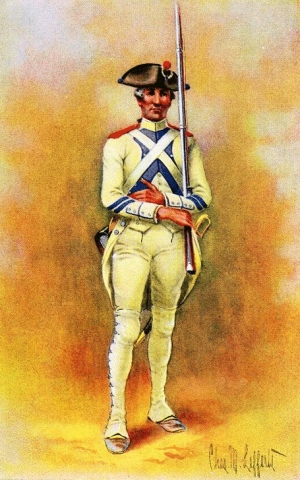By the ordonnance of March 25, 1776, the regiment d'Auvergne was split in two. The first and third battalions remained as d'Auvergne; the second and fourth battalions formed the regiment de G�tinais. It was the last [the G�tinais regiment] which in 1781 received the name of 'Royal-Auvergne'.
The Colonels of this regiment, or mestres de camp, were successively:
(1) The Marques de Caupenne (Louis-Henri), 18th April, 1776;
(2) The Count de Briey de Landres (Jean-Gabriel), 9th May, 1778;
(3) The Marquis de ROSTAING (Jean-Antoine-Marie-Germain), 27th October, 1778;
(4) The Viscount de Rochambeau (Donatien) 1st July, 1783;
(5) De Tourville (Charles-Bertin-Gaston Chapuis), 25th July, 1791;
(6) De Fontbonne (Alexandre-Louis), 8th July, 1792.
To distinguish itself from d'Auvergne, G�tinais adopted a yellow collar and white buttons. Its colors were black and violet. Most sources do not support Edward Richardson [Standards and Colors of the American Revolution (1982)] who describes the colors as black and marine blue.
The second battalion, which was at la Martinique since November 20, 1775, went to Saint-Domingo in 1777. The fourth battalion, which was at Calais in June, 1776, left at the end of that year for Bordeaux, and there embarked the 25th September, 1777, to rejoin the second battalion. The regiment remained in garrison at the Cape until 1779. That year it was placed on board of vessels of the fleet of Count d'Estaing, and the 15th September to 20th October was at the siege of Savannah. The companies of chasseurs coveted themselves with glory, the 9th of October, at the attack on the retrenchments. The sublieutenant LEVERT was the first to enter the entrenchments, whose defenders, astonished at such audacity, fled, throwing away their arms. The English, nevertheless, returned more numerous, and the brave G�tinais companies, without support, having lost the half of their number, were obliged to retire. They withdrew in good order, carrying off their dead and wounded, among whom the Viscount de B�thizy, colonel en second, with three wounds, in the left hand, the right arm, and in the stomach; Captain Sireuil, wounded with a bisca�en [musket shot] in the side; Captain de Foucault, knocked down by the concussion from a cannon ball; Lieutenant De Justajmont, killed outright; Chevalier de la Roche-Negley, who had received a bisca�en shot in the head and was later 'trepanned'; Chevalier de Tourville, wounded by a ball which passed from the right breast (t�ton) to the shoulder; sublieutenant Levert had his clothes riddled with bullets.
After, the siege was raised, the G�tinais returned to the Cape, and in 1781 it was made a part of the corps d'arm�e which the Marquis de Saint Simon led to the United States to reinforce Rochambeau. It took a glorious part in the siege of Yorktown and the capitulation of Lord Cornwallis. The 14th October, with the Royal Deux-Ponts regiment and under Lieutenant-colonel de Lestrade, it attacked with extreme bravery, and carried one of two redoubts on the left of the British defensive works. Captain Sireuil, of the chasseurs, was again wounded, this time very seriously, with two other officers. After the victory, Washington, expressed his admiration to the French units by presenting to the regiments G�tinais and Royal-Deux-Ponts the three pieces of cannon which they had captured from the redoubt 9. The G�tinais re-embarked soon after the British surrender and returned to Saint-Domingo.
An ordonnance of the 11th July, 1782, changed the name of the regiment and gave it, in recognition of its splendid conduct in America, the title of the 'Royal- Auvergne'. That favor was accorded the regiment at the request of Count Rochambeau, who, at the siege of Yorktown, at the moment of a decisive attack, addressing himself to the grenadiers de G�tinais, said: "Boys, show that G�tinais and Auvergne are one." The grenadiers swore to be slain, even to the last man, to merit that they be given back the title of 'Auvergne'.
In 1791 Royal-Auvergne became the eighteenth infantry, then was discharged in 1791. The eighteenth infantry, which has now [1903/5] succeeded, is in garrison at Pau.
Juste-Antoine-Henry-Marie-Germain, Marquis de ROSRAING, Colonel.
�TAT-MAJOR.
Colonel commandant.
Le marquis de ROSTAING (Juste-AntoineHenry-Marie-Germain). Le grade de brigadier lui a �t� conf�r�, 1e 5 d�c. 1781, pour s'�tre distingu� d � prise d'York,
Colonel en second.
Le vicomte de BETHISY (Jacques-El�onor), n� � Calais, le 4 d�c. 17-18. Bless� gri�vement � Savannah en 1779.
Lieutenant-colonel.
De l'ESTRADE (Claude), n� au Puy [Velay], le 5 avril 1730. Brigadier par distinction, le 5 d�c. 1781, our ses actions courageuses � Yorck, en V irginie.
Major.
CHAPUIS de TOURVILLE (CharlesBertin-Gaston), n� al Hettamre-la-Grande, le 4 janv. 1740. Bons services en Am�rique oil il a fait pr�s d'un an les fonctinne de major-g�n�ral.
The above text, with minor editing, is from Les Combattants Fran�ais de la guerre Am�ricaine 1778-1783. Du Minist�re des Affaires �trang�res, Genealogical Publishing Co., Baltimore, 1969. Listes �tablies d'aprees les documents authentiques d�pos�s aux Archives Nationales et aux Archives de Minist�re de la Guerre.] [58th Congress, 2d Sesssion, SENATE, document No. 77. [Soci�t� des fils de la R�volution am�ricaine]. The report was first published in Paris in 1903, pp.805-806.
Some confusion exists in the different spellings of the regiment's name. �Gatinois' is based upon early attempts to conform to some eighteenth-century pronunciations. However, modern convention has the proper spelling as �G�tinais'. The accent on the �e' is because the name to the Province comes from �Gastine'. The �s' is replaced by the �^' accent, like �le for Isle, etc.
|


